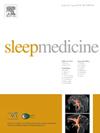Sleep apnea-specific hypoxic burden and pulse rate response in children using high flow nasal cannula therapy compared with continuous positive airway pressure
IF 3.4
2区 医学
Q1 CLINICAL NEUROLOGY
引用次数: 0
Abstract
Background
Elevated sleep apnea-specific hypoxic burden (HB) and pulse rate response (ΔHR) are associated with a higher cardiovascular risk in adults. The clinical significance of HB and ΔHR in children with obstructive sleep apnea (OSA) and their responses to therapy have not yet been investigated. This study aimed to compare the efficacy of high flow nasal cannula (HFNC) and continuous positive airway pressure (CPAP) in reducing HB and ΔHR in children.
Methods
This analysis included 17 children (11 males, mean age: 12.6 ± 3.9 years) with obesity and/or medical complexity and moderate-to-severe OSA. Each participant underwent two additional sleep studies: one for HFNC titration and another for CPAP titration. HB and ΔHR were derived from the oximetry and pulse rate signals from overnight sleep studies, respectively.
Results
Both HFNC and CPAP demonstrated significant reductions in HB from baseline, with similar magnitudes [HFNC: −129 (standard error, SE 55) %min/h, p = 0.003; CPAP: −138 (SE 53) %min/h, p = 0.005]. However, for ΔHR, a significant reduction from baseline was observed only in the CPAP group [–2.7 (SE 1.1) beats/min, p = 0.049], not the HFNC group [–1.0 (SE 1.4) beats/min, p = 0.67].
Conclusions
HFNC is as effective as CPAP in treating hypoxia in children with OSA, but HFNC might be less effective than CPAP in mitigating cardiovascular stress from autonomic disturbances during obstructive events.
与持续气道正压疗法相比,儿童使用高流量鼻插管疗法时的睡眠呼吸暂停特异性缺氧负担和脉率反应
背景睡眠呼吸暂停特异性缺氧负荷(HB)和脉率反应(ΔHR)升高与成人心血管风险升高有关。目前尚未研究阻塞性睡眠呼吸暂停(OSA)患儿的 HB 和 ΔHR 的临床意义及其对治疗的反应。本研究旨在比较高流量鼻插管(HFNC)和持续气道正压(CPAP)在降低儿童 HB 和 ΔHR 方面的疗效。方法本分析包括 17 名肥胖和/或病情复杂且患有中重度 OSA 的儿童(11 名男性,平均年龄:12.6 ± 3.9 岁)。每位参与者都接受了两次额外的睡眠研究:一次用于 HFNC 滴定,另一次用于 CPAP 滴定。HB 和 ΔHR 分别来自隔夜睡眠研究的血氧饱和度和脉搏信号。结果HFNC 和 CPAP 均显示 HB 从基线显著降低,降低幅度相似[HFNC:-129(标准误差,SE)]:HFNC:-129(标准误差,SE 55)%min/h,p = 0.003;CPAP:-138(标准误差,SE 53)%min/h,p = 0.003:CPAP:-138 (SE 53) %min/h,p = 0.005]。结论在治疗 OSA 患儿缺氧方面,HFNC 与 CPAP 一样有效,但在减轻阻塞事件期间自律神经紊乱对心血管造成的压力方面,HFNC 可能不如 CPAP 有效。
本文章由计算机程序翻译,如有差异,请以英文原文为准。
求助全文
约1分钟内获得全文
求助全文
来源期刊

Sleep medicine
医学-临床神经学
CiteScore
8.40
自引率
6.20%
发文量
1060
审稿时长
49 days
期刊介绍:
Sleep Medicine aims to be a journal no one involved in clinical sleep medicine can do without.
A journal primarily focussing on the human aspects of sleep, integrating the various disciplines that are involved in sleep medicine: neurology, clinical neurophysiology, internal medicine (particularly pulmonology and cardiology), psychology, psychiatry, sleep technology, pediatrics, neurosurgery, otorhinolaryngology, and dentistry.
The journal publishes the following types of articles: Reviews (also intended as a way to bridge the gap between basic sleep research and clinical relevance); Original Research Articles; Full-length articles; Brief communications; Controversies; Case reports; Letters to the Editor; Journal search and commentaries; Book reviews; Meeting announcements; Listing of relevant organisations plus web sites.
 求助内容:
求助内容: 应助结果提醒方式:
应助结果提醒方式:


